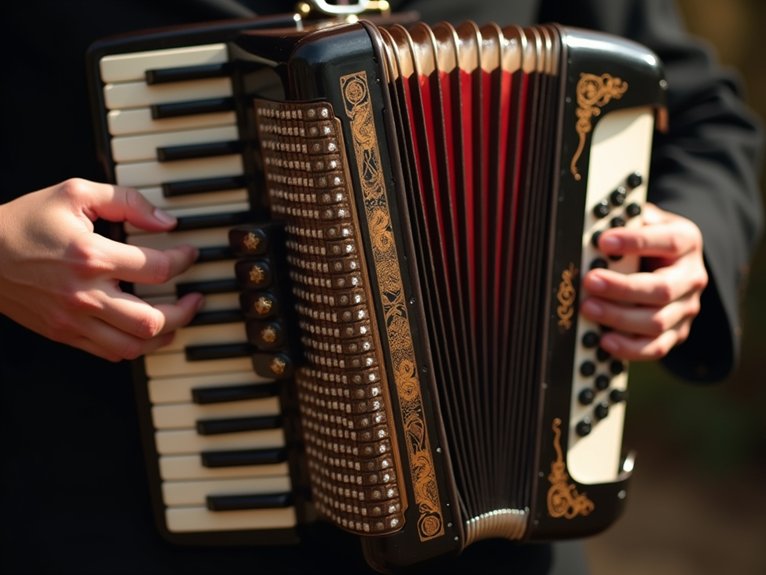Learning accordion begins with selecting the right type and size for your body and musical goals. Start with a student model (12-48 bass) or consider renting to test comfort. Proper posture is vital: sit straight, use back straps, and keep the instrument against your chest with relaxed shoulders. Practice bellows control daily using a metronome to develop consistent pressure and articulation. The journey continues with understanding notation and building fundamental techniques.
Understanding the Different Types of Accordions

Before selecting an instrument to learn, aspiring accordionists must familiarize themselves with the main accordion types available. The piano accordion features piano-style keys for the right hand and is common in folk and classical music.
Button accordions use buttons instead of keys and include diatonic models (playing different notes on push and pull) and chromatic varieties (same note regardless of direction).
Concertinas are smaller hexagonal or octagonal accordions offering a more portable option. Each type produces distinct sounds and suits different musical styles. Consider size, weight, and musical goals when choosing the appropriate accordion for teaching or performance purposes.
Choosing Your First Accordion: Size and Budget Considerations
When selecting a first accordion, beginners should consider both physical dimensions and financial constraints to guarantee a suitable investment. Student models (12-48 bass buttons) offer affordability while providing essential features for learning fundamentals. These typically range from €280-745, compared to professional instruments exceeding €1,865.
Physical comfort remains paramount—the instrument should correspond to the player’s body size. Children and smaller adults may require 12-24 bass models, while average adults can manage 48-72 bass accordions comfortably. Rentals provide an excellent option for determining appropriate sizing before committing to purchase, allowing learners to experience the instrument’s weight and ergonomics firsthand.
The Fundamental Parts of an Accordion

Once an appropriately sized accordion has been selected, understanding its anatomy becomes the next step in the learning process. The accordion consists of three main sections: the treble keyboard (right hand), the bass buttons (left hand), and the bellows connecting them.
The treble side typically features piano-style keys or buttons, depending on the accordion type. The bass side contains buttons arranged in rows for playing bass notes and chords. The bellows, the accordion’s lungs, create airflow across internal reeds when compressed or expanded, producing sound. Understanding these components establishes the foundation for proper handling and technique.
Proper Posture and Holding Techniques
Establishing proper posture forms the cornerstone of successful accordion playing. Players should sit on the front half of a straight-backed chair with feet flat on the floor. The back strap supports the instrument while the left hand operates the bass buttons and the right hand plays the keyboard.
The accordion should rest against the player’s chest with the bellows moving parallel to the torso. Shoulders remain relaxed and level, avoiding unnecessary tension. Elbows stay close to the body while maintaining flexibility for bellows movement. Proper positioning prevents fatigue and potential injuries during extended playing sessions, allowing musicians to focus on technique rather than discomfort.
Mastering Bellows Control

Bellows control serves as the fundamental skill separating novice accordionists from experienced players. Mastery requires understanding the bellows’ role in sound production and musical expression.
Players should practice steady pressure techniques to maintain consistent volume while playing. Begin with simple exercises: sustained single notes, followed by scales at various speeds. Focus on producing even tones during both bellows compression and expansion.
Dynamic control develops through practicing crescendos and diminuendos. Accordionists should learn bellows articulation—short, defined movements that create staccato effects. Advanced techniques include bellows shakes and subtle pressure variations for vibrato effects.
Regular practice with metronome guidance helps build muscle memory and timing precision essential for expressive performances.
Learning the Right-Hand Keyboard
The right-hand keyboard, with its piano-style layout, represents the melodic heart of the accordion. Beginners should start by identifying the C note, typically marked on the keyboard, and practice the C major scale. Familiarity with basic finger positioning—using all five fingers in proper sequence—creates a foundation for melodic playing.
Daily practice of simple melodies helps develop muscle memory and hand positioning. Players should gradually incorporate both hands, coordinating right-hand notes with left-hand chord accompaniment. Regular scale practice in common keys (C, G, F major) builds dexterity and musical understanding necessary for performing complete pieces with confidence.
Navigating the Left-Hand Bass Buttons
Mastery of the accordion requires thorough understanding of the left-hand bass button system, which provides harmonic foundation and rhythmic structure. The Stradella bass system, most common for beginners, arranges buttons in diagonal rows of fundamental basses and chord buttons.
Players should first locate the C bass button, typically marked with a dimple or unique texture. Practice involves sliding horizontally to navigate fundamental basses and vertically to access chord variations. Regular exercises combining single bass notes with major, minor, and seventh chords build muscle memory.
Beginners should start with simple patterns in C and G major before progressing to more complex accompaniments, gradually synchronizing left-hand bass patterns with right-hand melodies.
Reading Music and Accordion Notation
While standard sheet music forms the foundation of accordion notation, several specialized symbols and techniques are unique to the instrument. Accordion music typically displays two staves—treble clef for the right hand and bass clef with chord symbols for the left.
Bass buttons appear as letters with symbols indicating major (M), minor (m), seventh (7), or diminished (°) chords. Bellows direction markers show when to push (∨) or pull (∧) for proper expression.
Registration marks indicate which reed banks to engage, controlling timbre and volume. Beginners should start with simple pieces that use basic notation before progressing to more complex accordion-specific symbols.
Essential Practice Exercises for Beginners
Consistent daily practice forms the cornerstone of accordion proficiency for beginners. New students should allocate 15-30 minutes daily to fundamental exercises, gradually increasing duration as skills develop.
Essential practice routines include:
- Scale exercises (C major and G major initially)
- Basic bellows control drills
- Single-note right-hand melodies
- Simple left-hand chord progressions
- Coordination exercises combining both hands
Beginners should master slow, deliberate movements before attempting increased tempo. Recording practice sessions enables self-assessment of progress. Teachers recommend focusing on proper posture and hand position during all exercises to prevent developing problematic habits that impede advancement.
Building Your First Accordion Repertoire
After developing basic technical skills through foundational exercises, beginners should establish a well-rounded accordion repertoire that gradually increases in complexity.
Most instructors recommend starting with folk tunes like „Ode to Joy” or „Scarborough Fair,” which utilize simple bass patterns and right-hand melodies. Traditional polkas and waltzes provide excellent practice for coordination while introducing basic rhythmic patterns.
As confidence grows, students can progress to light classical pieces by composers like Mozart or Bach, specifically arranged for accordion. Adding popular songs that students recognize maintains motivation and enjoyment.
A balanced repertoire should include varied tempos, styles, and technical challenges to develop extensive musicianship while keeping practice sessions engaging.
Finding Resources: Teachers, Communities, and Online Tutorials
Although self-learning is possible, securing proper resources dramatically accelerates a beginner’s accordion journey. Local music schools often offer accordion instruction, while dedicated teachers provide personalized feedback essential for proper technique development.
Online communities connect enthusiasts worldwide, offering encouragement and practical advice. Forums like Accordionists & Teachers Guild International and accordion-focused social media groups provide valuable support networks.
Digital platforms present diverse learning opportunities through structured video tutorials, interactive lessons, and downloadable sheet music. Websites such as AccordionLife, Liberty Bellows, and Accordion Academy feature progressive lessons suitable for various skill levels.
Free resources on YouTube complement paid courses, providing demonstrations of specific techniques and repertoire guidance.



